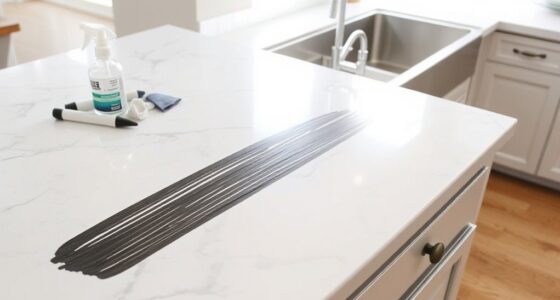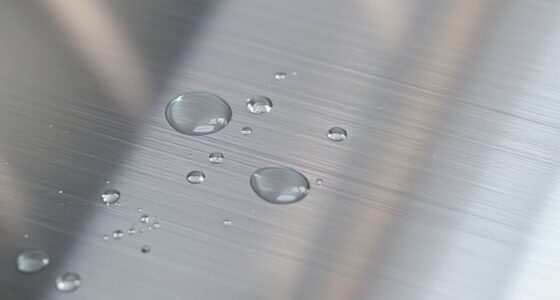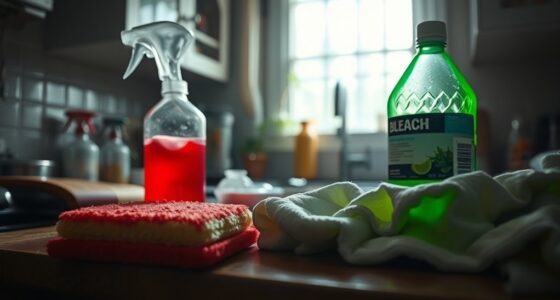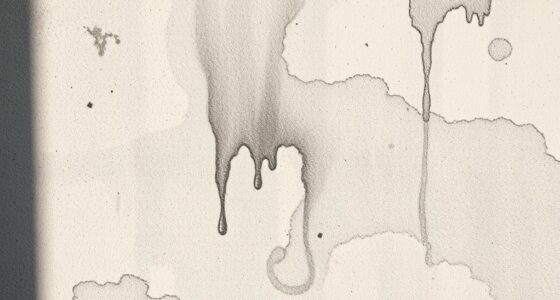To remove rust stains from sinks and tubs using oxalic acid, start by dampening the stain area, then apply a commercial rust remover containing oxalic acid or make a paste from oxalic acid and water. Let it sit for 5-10 minutes, but don’t let it dry completely. Gently scrub with a soft brush or sponge, rinse thoroughly, and dry. If you want to discover more effective tips, keep exploring this approach further.
Key Takeaways
- Oxalic acid effectively dissolves iron oxide rust stains in sinks and tubs.
- Apply dampened oxalic acid to the stain, let sit for 5-10 minutes, then scrub gently.
- Always wear gloves and work in well-ventilated areas when using oxalic acid.
- Test on a small area first to prevent damage to fixtures.
- Follow manufacturer instructions for safe and effective rust stain removal.
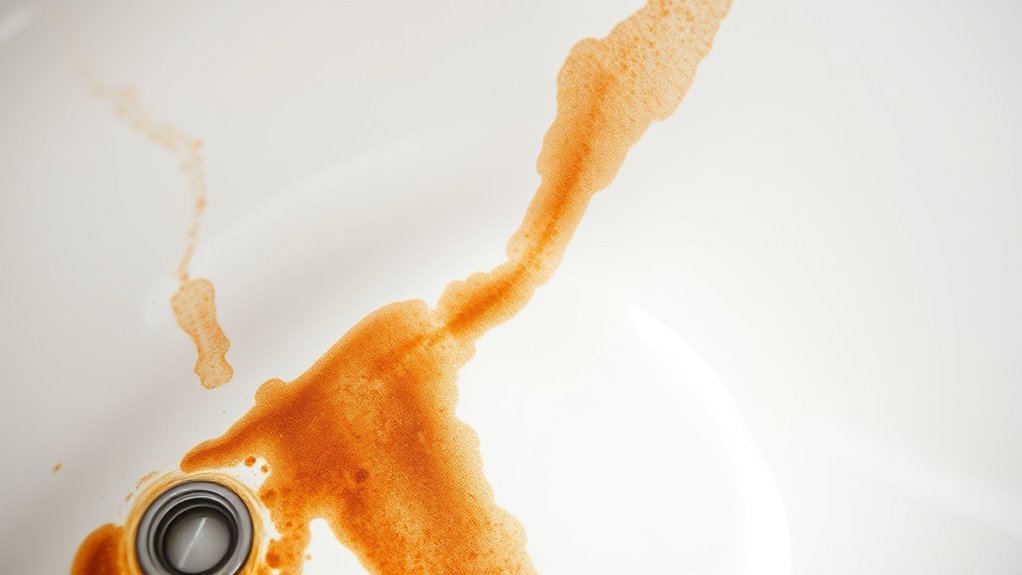
Rust stains in sinks and tubs can quickly turn a clean space into an eyesore, but thankfully, they’re usually easy to remove with the right approach. When it comes to bathroom cleaning, knowing effective stain removal techniques is essential to restore your fixtures’ shine and prevent further damage. Rust stains are caused by iron deposits reacting with water and air, leaving behind stubborn orange or reddish marks that seem to cling stubbornly. While regular cleaning can keep your bathroom looking fresh, rust stains often require targeted treatments to fully eliminate them.
Rust stains can be easily removed with proper techniques, restoring your bathroom’s shine and preventing further damage.
One of the most effective stain removal techniques involves using oxalic acid, a powerful compound known for its ability to dissolve rust. This chemical is found in some commercial rust removers or can be prepared at home using natural ingredients like rhubarb or spinach, which contain oxalic acid. When applying oxalic acid, always wear gloves and work in a well-ventilated area to avoid skin or respiratory irritation. To start, dampen the stained area with water, then carefully apply the oxalic acid solution directly onto the rust. Let it sit for 5-10 minutes, but don’t let it dry out completely. During this time, the acid penetrates the rust, breaking down the iron oxides. Afterward, scrub gently with a soft brush or sponge to lift the stain. Rinse thoroughly with water to remove any residue. Repeat if necessary, but avoid overusing to prevent damage to your sink or tub surface.
For those preferring natural methods, lemon juice combined with baking soda can sometimes do the trick. The acid in lemon helps loosen rust, while baking soda acts as a gentle abrasive to scrub away stains. Mix equal parts lemon juice and baking soda to form a paste, then apply it to the rust spots. Allow it to sit for about 15 minutes before scrubbing with a soft cloth or sponge. Rinse well with water afterward. This method is eco-friendly and less harsh than chemical alternatives, making it suitable for regular maintenance.
While oxalic acid is highly effective, always follow manufacturer instructions carefully and test a small, inconspicuous area first. Proper bathroom cleaning and timely stain removal can keep rust from becoming a persistent problem, saving you time and effort in the long run. Remember, addressing rust stains early with the right stain removal techniques not only improves your bathroom’s appearance but also prolongs the life of your fixtures.
Frequently Asked Questions
Can Oxalic Acid Damage Porcelain or Acrylic Surfaces?
Oxalic acid is generally safe for porcelain surfaces if you follow proper application instructions, so Porcelain safety is maintained when used correctly. However, you should be cautious with acrylic surfaces, as they can be more sensitive and may get damaged or discolored. Always test a small, hidden area first and avoid prolonged contact. Using the right concentration and rinsing thoroughly helps prevent any Acrylic concerns.
Are There Eco-Friendly Alternatives to Oxalic Acid for Rust Removal?
Think of eco-friendly alternatives as gentle warriors fighting rust. You can use natural rust removers like lemon juice, vinegar, or baking soda—these are safe, biodegradable options that protect your surfaces. They’re symbolized by the sun’s warmth and earth’s purity. These natural remedies effectively break down rust without harsh chemicals, making them ideal eco-conscious choices. So, yes, you have effective, natural rust removers that are safe for your home and the planet.
How Long Does It Typically Take for Oxalic Acid to Work?
You can expect oxalic acid to start showing results within 5 to 15 minutes, but the effectiveness timeline varies depending on stain severity. For lighter rust, it may work quickly, while stubborn stains might need up to 30 minutes or more. Keep an eye on the area, and if needed, reapply or scrub gently to enhance results. Patience is key for best rust removal outcomes with oxalic acid.
Is Oxalic Acid Safe for Use Around Children and Pets?
You should avoid using oxalic acid around children and pets due to safety concerns. While it’s effective for removing rust stains, it’s important to take child safety and pet precautions—this chemical can be toxic if ingested or mishandled. Always keep it out of reach, wear gloves, and ensure proper ventilation. For a safer alternative, try natural cleaning solutions or consult a professional to protect your loved ones.
What Should I Do if I Accidentally Spill Oxalic Acid?
If you accidentally spill oxalic acid, act quickly for emergency cleanup. Put on gloves and protective gear, then neutralize the spill with baking soda or plenty of water. Avoid inhaling fumes or letting it contact your skin. Once cleaned, guarantee proper disposal by sealing the residues in a plastic bag and following local hazardous waste guidelines. Always store oxalic acid safely to prevent future accidents.
Conclusion
Now that you know how oxalic acid can tackle rust stains, you’ll feel more confident tackling those stubborn spots. Remember, a stitch in time saves nine—addressing stains early prevents bigger messes later. With a little effort and the right product, your sinks and tubs will look fresh and clean again. Don’t let rust win; take action today, and enjoy a sparkling, stain-free space tomorrow. Cleanliness is next to godliness, after all!


